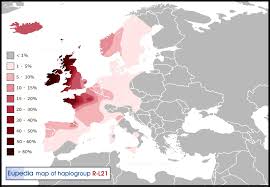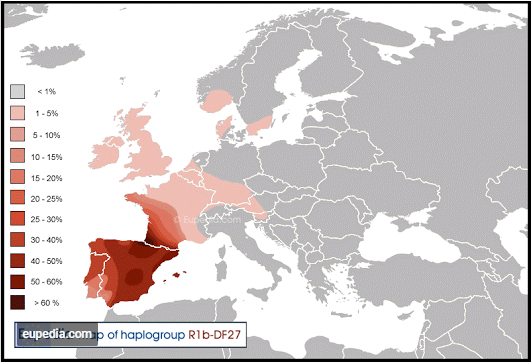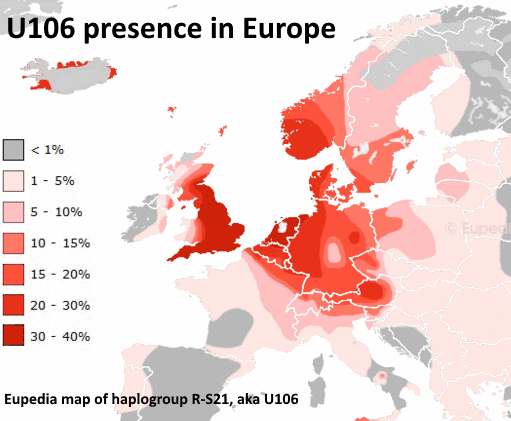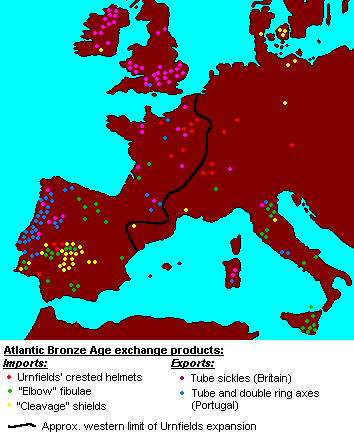Introduction
My Y-DNA, which tracks my male ancestors (same Surname), indicates that I have Celtic roots (L21 haplogroup). The results of my research on Y-DNA suggest that I have connections, that may extend back for thousands of years, to people who lived in Britain and along the Rhine River in Europe. The links to the Rhine are not as strong as those for England and Scotland but the underlying data is biased towards the former. Separate analysis of my Ancestry DNA matches suggest that I have distant (5+ cousin) connections to people with similar surnames who lived in Britain and along the Rhine River hundredths of years ago.
The Rhine or Britain
The Rhine River begins in the southeastern Swiss Alps, forms part of the Swiss-Liechtenstein, Swiss-Austrian, Swiss-German and then the Franco-German border, then flows through the German Rhineland and the Netherlands and eventually empties into the North Sea (Wiki).

This section explores connections between the Rhine and Britain. The Mesolithic people who settled Britain after the end of the last Ice Age had their origins in Europe. Ancient DNA evidence such as that from Cheddar Man , a 10,000-year-old skeleton discovered near the village of Cheddar in Somerset, indicates that these early settlers likely only contributed around 10% of the DNA found in people who current live in the British Isles. My Mitochondrial DNA Haplogroup (U5B2A1B) suggest that I might share a common maternal ancestor with Cheddar Man around 20,000 years ago. Pre-Stonehenge artifacts like a 5,000 year old polished Jade axe found in Canterbury, England but made in the Alps suggest that there was some contact between Europe and Britain during the late Neolithic in Britian (4000 BC to circa 2,500 BC) .
Recent Archaeological research supported by analysis of ancient DNA has established that people linked to the Bell Beaker culture (defined by a style of pottery) , which had its origins in the European Alps, arrived in England around 2440 BC. The ancestors of the Beaker Culture were a group of people living in Central Europe whose ancestors had previously migrated from the Eurasian Steppe. Earlier (pre DNA) research had assumed the Beaker Culture spread to Britain by diffusion of ideas rather than migration (see following nap) but the latest DNA research shows that it was due to migration.

The evidence for a migration of people rather than cultural diffusion comes from recent analysis of Ancient DNA samples from sites in Britain. These DNA samples indicate that after the arrival of the Beaker culture 90% of the existing male Neolithic population (the builders of Stonehenge) vanished in just 300 years and were replaced with individuals with the R1b Y-DNA Haplogroup (linked to Beaker culture in Europe).

arrival of the Beaker complex Source: The Beaker phenomenon and the genomic
transformation of northwest Europe, Nature 2018.
A number of the post 2400 BC Ancient DNA samples from Britain were identified as Haplogroup L21 (a subclade of R1b) which is the Haplogroup associated with the Celtic culture in the UK and Ireland. My terminal Haplogroup is a subclade of L21 which is a subclade of R1b (see my page on My Y-DNA Results). One of the Ancient L21 samples was associated with the Amesbury Archer burial (near Stonehenge) dated to c 2300 BC. Oxygen isotope analysis of the Archer’s tooth enamel has suggested that he spent his early life in the alpine region of central Europe. The origin of the mutation linked to the L21 Haplogroup has been estimated to be around 2500BC (dating of mutations involves estimations of the average number of mutations from the founder haplotype to all modern-day haplotypes; the age of the mutation can then be estimated by multiplying this number by an assumed mutation rate). This close correspondence in dates between the arrival of the Bell Beaker culture in Britain, the estimated origin of the L21 mutation and the ancient L21 DNA sample from Amesbury makes it difficult to establish if the Beaker people brought the L21 mutation to Britain or if it developed there after their arrival. This question is important since the answer will determine whether ancestors of the L21 individuals currently living in mainland Europe (see map below) had their origin there or migrated back to Europe from south-west England as some researchers argue.

My bet is that L21 originated among the Bell Beaker people in Europe and some of these L21 individuals were part of the 2400 BC migration to Britain. The current distribution of L21 individuals likely resulted from the L21 people representing a significant proportion of the initial migrants in Britain (founder effect) combined with later displacement (e.g. Roman period) of L21 (Celtic) populations in Europe. If the L21 Haplogroup had its source in Europe then it is likely that it was in Brittany or the lower Rhine.
The latest research ( Olalde , March 2019) demonstrates that around the same time frame (2500 BC) other Central European people with Steppe Ancestry migrated into Iberia and replaced 40% of Iberia’s [pre contact] ancestry and nearly 100% of its Y-chromosomes by people with Steppe ancestry. This indicates that the change was a result of male invaders (Y DNA changing) mating with local females (mtDNA remaining constant). These Iberian invaders were likely responsible for introducing the sub group of R1b identified by the marker DF27 (also known as S250). Research by Neus Solé-Morata et. al. (2017) found that R1b-DF27 is present in frequencies ~40% in Iberian populations . Overall, the age of R1b-DF27 is estimated at ~4,200 years ago, at the transition between the Neolithic and the Bronze Age, when the Y chromosome landscape of W Europe was thoroughly remodeled.

The third major branch of the R1b people identified by the SNP S21, commonly referenced as U106, likely had its origin in NW Europe c 2500-3000 BC is now the most frequent group in the Netherlands, northwest Germany and England. In Roman times this was likely the dominant haplogroup among the “Barbarian” Germanic tribes that lived along the east bank of the Rhine. The presence of R1b-S21 in Britain can be attributed to the Germanic migrations that took place between the 3rd and the 10th century (Frisians and Anglo-Saxons) that disseminated this haplogroup to England and the Scottish Lowlands.

Bronze Age
The Bell Beaker migration to Britain marked the start of the Bronze Age (c 2500 until c. 800 BC) in Britain. During the early Bronze Age the Wessex Culture was the predominant prehistoric culture of central and southern Britain . They appear to have had wide ranging trade links with continental Europe, importing amber from the Baltic, jewellery from modern day Germany, gold from Brittany as well as daggers and beads from Mycenaean Greece and vice versa. It has been speculated that river transport allowed Wessex to be the main link to the Severn estuary. The culture was related to the Hilversum culture of the southern Netherlands, Belgium and northern France, and linked to the Pre Celtic cultures of the French Armorican region and the Middle Rhine.

Iron Age
Over time the various Bronze Age cultures (as reflected in their artifacts) found in Continental Europe gradually evolved until by the start of the Iron Age (around 800 BC) the Hallstatt culture was the predominant Culture in Western Europe. Along with the culture the languages spoken by these people evolved into what is now considered the Celtic language. Today, Celtic Languages are restricted to the northwestern fringe of Europe with only four living Celtic languages: Welsh, Breton, Irish and Scottish Gaelic; however around 270 BC, Celtic languages were spoken across much of Europe (see Map).

Findings from Archaeological sites in the Black Forest of Germany (headwaters of Rhine) show that Celtic culture was thriving in this area around 600 BC; however, there is no human DNA evidence from these sites. This area is currently at the edge of the modern distribution of the three R1b subclades discussed earlier so currently it is impossible to say if this area might have had a significant population of L21 people that were subsequently displaced by Roman and Germanic (R1b-S21) invasions.
Evidence for similar displacements are found in the United Kingdom. Despite the changes that occurred in British DNA 4400 years ago the present day DNA profile of the UK is a mixture of the DNA from the early Neolithic population, the Bell Beaker Pre-Celtic people, later Pre-Roman Celtic migrants, Roman era migrations, Germanic (Anglo Saxon) migrants (R1b-S21) combined with DNA from later Scandinavian and Norman invaders.

Further down the Rhine at Heidelberg there was a 5th century BC Celtic fortress and near here the 5th – 4th century B.C Celtic Heidelberg Head was found. There are numerous Celtic sites between Heidelberg and the French border. Around the same time Celtic tribes also lived in what is now Luxembourg and along the Moselle a tributary of the Middle Rhine. Just 30 km upstream of where the Moselle joins the Rhine (at Koblenz) is Pfalzfeld where a 1.5m tall 4th century BCE Celtic burial pillar was found in the 17th century. The pillar is sculptured and covered with many ornaments and is shows four human heads with the typical celtic “leaf-crowns”.

The area between Heidelberg and Pfalzfeld has the strongest links to my Y-DNA.
Celts & Romans
In Caesar’s time, the Carnutes occupied a considerable territory, extending from the Seine to the Loire, and south of the Loire. Their principal town, Genabum (Orleans), was on the north side of the Loire (B. G. 7.11); and they had another town, Autricum (Chartres, Ptol. 2.8), which derives its modern name from that of Carnutes, which was the name of Autricum under the later Roman empire. Strabo (p. 191) describes the position of Orleanspretty correctly by saying that it is about the middle of the course of the Loire.Caesar says, that the territory of the Carnutes was reckoned the central part of all Gallia (B. G. 6.13), and that the Gallic Druids met in this country once a year in a consecrated place. The territory comprehended the dioceses of Chartres, Orlèans,and Blois. Two places called Fins (Fines), on the borders of the diocese of Chartresand Orleans, and a place called Terminier, show that the division of the territory of the Carnutes belongs to the Roman period. The Bituriges were the neighbours of the Carnutes on the south, and the Senones on the east. (Source)

Celtic Missions to France and Germany
The Hiberno-Scottish mission was a series of missions and expeditions initiated by various Irish clerics and cleric-scholars who, for the most part, are not known to have acted in concert.[1] There was no overall coordinated mission, but there were nevertheless sporadic missions initiated by Gaelic monks from Ireland and the western coast of Scotland, which contributed to the spread of Christianity and established monasteries in Britain and continental Europe during the Middle Ages. The earliest recorded Irish mission can be dated to 563 with the foundation of Iona by the Irish monk Saint Columba. Columba is said by Bede and Adamnán to have ministered to the Gaels of Dál Riada and converted the northern Pictish kingdoms. Over the next centuries more missions followed and spread through Anglo-Saxon England and the Frankish Empire. Since the 18th and 19th centuries, these early missions were called ‘Celtic Christianity‘, though aside from some idiosyncratic cultural features, this version was still orthodox and maintained relationships with the Holy See.[2]
Irish abbot and missionary Columba founded the abbey of Iona off the western coast of modern-day Scotland in 563. Following that was the foundation of Lindisfarne in 635 by the Irish monk Saint Aidan. The missions continued throughout most Anglo-Saxon kingdoms during the following decades; the last pagan Anglo-Saxon king, Arwald of the Isle of Wight, was killed in battle in 686.
Columbanus was active in the Frankish Empire from 590, establishing monasteries until his death at Bobbio in 615. He arrived on the continent with twelve companions and founded Annegray, Luxeuil, and Fontaines in France and Bobbio in Italy. During the 7th century the disciples of Columbanus and other Gaeil missionaries founded several monasteries in what are now France, Germany, Belgium, and Switzerland. The best known are: St. Gall in Switzerland, Disibodenberg in the Rhine Palatinate, St. Paul’s at Besançon, Lure and Cusance in the Diocese of Besançon, Bèze in the Diocese of Langres, Remiremont Abbey and Moyenmoutier Abbey in the Diocese of Toul, Fosses-la-Ville in the Diocese of Liège, Mont Saint-Quentin at Péronne, Ebersmunster in Lower Alsace, St. Martin’s at Cologne, the Scots Monastery, Regensburg, Vienna, Erfurt and Würzburg. In Italy, Fiesole produced Saint Donatus of Fiesole and Andrew the Scot of Fiesole. Another early Schottenkloster was Säckingen in Baden, founded by the Irish missionary Fridolin of Säckingen who is said to have founded another at Konstanz. Other Hiberno-Scottish missionaries active at the time, predominantly in Swabia, were Wendelin of Trier, Kilian, Arbogast, Landelin, Trudpert, Pirmin (founded Reichenau abbey), Saint Gall (Abbey of St. Gall), Corbinian, Emmeram and Rupert of Salzburg.